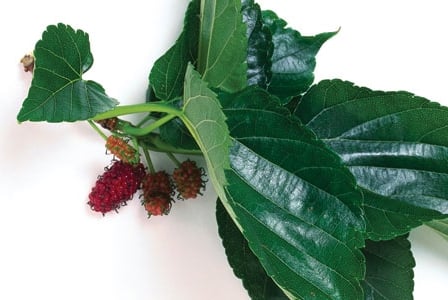
Research has been focused on the use of muberry leaf extract as a significant medicine for type 2 diabetes and atherosclerosis, as well as other health benefits.
Many people associate mulberry with the Mother Goose rhyme that goes: “Here we go round the mulberry bush,” yet this plant has a much longer history of use.
The mulberry leaves are not only the exclusive food of silkworms, but they have also been used by humans as medicine in India and China for hundreds of years, mostly for headaches, coughs, eye infections, nosebleeds, and fevers associated with influenza.
More recently research has been focused on the use of mulberry leaf (Morus alba, M. indica) extract as a significant medicine for type 2 diabetes and atherosclerosis.
Mulberry leaves have a high nutrient and antioxidant profile. They contain a wide variety of nutrients, including proteins, sugars, polyphenols, flavonoids (iso-quercitrin), steroids, triterpenes, vitamins, and minerals.
Mulberry Controls Blood Sugar
Several research groups have found that white mulberry leaves contain compounds that inhibit intestinal enzymes which break down disaccharides (especially sucrose), thereby restricting the amount of simple sugar that enters the circulatory system.
Researchers also found that feeding both rats and humans mulberry leaf extract prior to consuming carbohydrates significantly suppressed the normal post-meal rise in blood glucose levels.
Mulberry Inhibits Atherosclerosis
Researchers have pinpointed a number of biologically active compounds in mulberry leaf extract that are effective in suppressing the progression of atherosclerosis, the buildup of cholesterol-rich plaque in our arteries.
It does this, apparently, by inhibiting the oxidation of LDL (bad) cholesterol, which is a major factor in the development of atherosclerotic plaque. It appears this is primarily (but not exclusively) due to the antioxidant effects of two closely related compounds, iso-quercitrin and astragalin, found in mulberry leaf extract.
When the mulberry leaf was compared to a standard antidiabetic drug, Diabeta (glibenclamide, a.k.a. glyburide), not only did the mulberry leaf do better, but it also significantly improved the blood cholesterol and triglyceride profiles of the test subjects. Many patients have also reported weight loss, which they attribute to the consumption of mulberry leaf extract.
Health care practitioners who are using mulberry leaf extracts are still working out the proper dosage, but the average dosage for the extract is 100 mg of 30:1 extract, twice daily.
Since both blood sugar and blood lipid problems are among our country’s worst health problems, breakthroughs in this area are always inviting. It looks as though this nursery rhyme may indeed have a happy ending.

